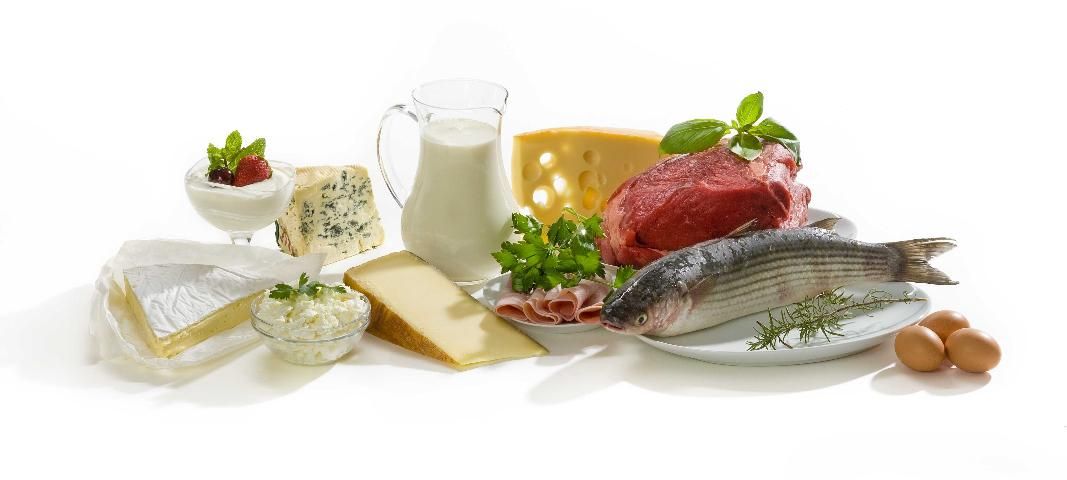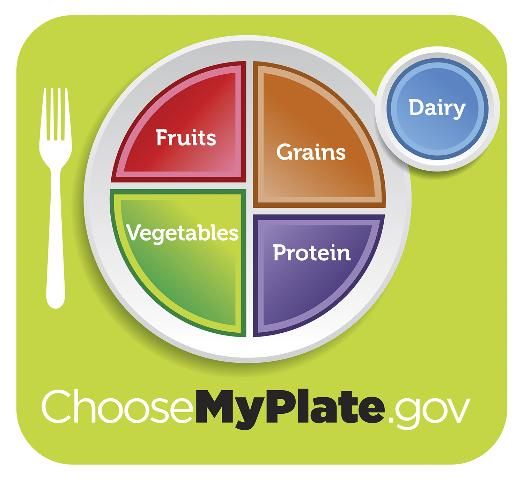Protein Basics
Our bodies are made of many proteins. Proteins are made from amino acids, and each protein has its own unique amino acid sequence that determines its shape and function. There are twenty different amino acids. Our bodies can make 11 of the amino acids that are needed to make protein but cannot make the other 9, so we must get them from our diet. These amino acids are considered "essential." Foods that provide high levels of all the essential amino acids are meat, poultry, eggs, fish, milk, cheese, and yogurt. Proteins low in one or more of the essential amino acids include those from plant foods: vegetables, fruits, grains, most legumes, nuts, and seeds. Although it is not necessary to eat foods containing all the essential amino acids at every meal, it is important for good health to ensure that what you eat over the course of the day provides enough of all the essential amino acids and total protein. This is especially true for those who eat only plant sources of protein, such as vegans. If vegans eat a varied diet containing vegetables, legumes, grains, nuts, and seeds, they should have no problem getting enough of each of the essential amino acids and meeting their protein needs.

Role of Proteins in the Body
Proteins have many functions in the body. For example, proteins help with digestion. They also help with the formation of red blood cells that deliver oxygen to our cells. They provide the framework and support for muscles, bones, skin, cartilage, hair, nails, teeth, and skin. Proteins also help the body fight infections.
Recommended Intake
The Recommended Dietary Allowance (RDA) for protein is 0.8 grams of protein for every 2.2 pounds (1 kilogram) of body weight for adult men and women who are not pregnant or breastfeeding. Table 1 lists estimated RDAs for protein based on reference body weights. Protein needs vary with age, sex, and body weight. Use this equation to calculate your daily protein requirement, in grams: (Your Weight in Pounds/2.2) x 0.8.
Sources of Protein
Sources of protein include meats, poultry, nuts, seeds, seafood, eggs, legumes (beans, peas, and lentils), soy-based foods, dairy foods, and grains. Table 2 lists examples of protein sources and the amount of protein they provide in each serving.
Protein Intake and Your Health
Most people eat more protein than they need without harmful side effects. However, some protein choices can be less healthy than others because they contain saturated fat. Saturated fat raises low-density lipoprotein (LDL) cholesterol levels, increasing the risk of heart disease and stroke. Fatty meats, poultry with the skin, sausage, hot dogs, and bacon are examples of sources of protein that are high in saturated fat. Replacing these options with sources of protein lower in saturated fat intake is recommended (USDA and USDHHS 2020) to lower the risk of heart disease events such as heart attack (Hooper et al. 2020).

How to Make Healthier Protein Choices
For healthier eating, choose lean or low-fat meat and poultry. Lean beef cuts include top sirloin and chuck shoulders. Lean pork includes pork loin, tenderloin, and ham. Extra-lean ground beef should say "90% lean/10% fat" on the package. When buying chicken and turkey, look for the skinless options. Limit or avoid deli meats due to their high sodium content and potentially high saturated fat content.
Vary your protein choices. Make it a goal to have seafood at least twice a week. Fish containing omega-3 fatty acids may to help to reduce the risk of stroke (Hu, Hu, and Manson 2019) and heart disease (Mohan et al. 2021). Choose fish high in omega-3 fatty acids such as salmon, lake trout, mackerel, and herring. Choose unsalted nuts and seeds, such as pecans, almonds, or pumpkin seeds. Using visual cues for portion control will help to control the amount you eat. MyPlate (Figure 3) is a great way to determine the proper amount of protein that should be served (USDA n.d.). Protein foods should take up a little less than ¼ of your plate. Dairy foods such as milk, yogurt, and low-fat cheeses are also good sources of protein as are soy-based foods.

Summary
There are many sources of dietary protein. Meat, poultry, eggs, fish, and dairy products are sources that provide a high level of essential amino acids that our bodies need. Plant foods such as grains, legumes, nuts, and seeds are also sources of protein. It is best to eat a variety of sources throughout the day to meet your needs. The Recommended Dietary Allowance (RDA) is 0.8 grams of protein for every 2.2 pounds (1 kilogram) of body weight. It is vital to consume the recommended amount of protein daily because proteins have many different roles in the body. Choosing protein sources such as lean meat, skinless poultry, fish, eggs, legumes, and unsalted nuts and seeds is an excellent way to get the protein you need in a healthier way.
References
Hooper, L., N. Martin, O. F. Jimoh, C. Kirk, E. Foster, and A. S. Abdelhamid. 2020. "Reduction in saturated fat intake for cardiovascular disease." Cochrane Database Syst Rev 5 (5):Cd011737. doi: 10.1002/14651858.CD011737.pub2.
Hu, Y., F. B. Hu, and J. E. Manson. 2019. "Marine Omega-3 Supplementation and Cardiovascular Disease: An Updated Meta-Analysis of 13 Randomized Controlled Trials Involving 127 477 Participants." J Am Heart Assoc 8 (19):e013543. doi:10.1161/jaha.119.013543.
Institute of Medicine, Food and Nutrition Board. 2005. Dietary Reference Intakes for Energy, Carbohydrate, Fiber, Fat, Fatty Acids, Cholesterol, Protein, and Amino Acids," pp. 339–421. Washington, DC: The National Academies Press.
Mohan, D., A. Mente, M. Dehghan, S. Rangarajan, M. O'Donnell, W. Hu, G. Dagenais, A. Wielgosz, S. Lear, L. Wei, R. Diaz, A. Avezum, P. Lopez-Jaramillo, F. Lanas, S. Swaminathan, M. Kaur, K. Vijayakumar, V. Mohan, R. Gupta, A. Szuba, R. Iqbal, R. Yusuf, N. Mohammadifard, R. Khatib, K. Yusoff, S. Gulec, A. Rosengren, A. Yusufali, E. Wentzel-Viljoen, J. Chifamba, A. Dans, K. F. Alhabib, K. Yeates, K. Teo, H. C. Gerstein, and S. Yusuf. 2021. "Associations of Fish Consumption With Risk of Cardiovascular Disease and Mortality Among Individuals With or Without Vascular Disease From 58 Countries." JAMA Intern Med 181 (5):631-649. doi: 10.1001/jamainternmed.2021.0036.
U.S. Department of Agriculture. “Are you making every bite count?” MyPlate. n.d. Retrieved April 2, 2022, from https://www.myplate.gov/
U.S. Department of Agriculture and U.S. Agricultural Research Service. n.d. “FoodData Central.” https://fdc.nal.usda.gov/index.html
U.S. Department of Agriculture and U.S. Department of Health and Human Services. Dietary Guidelines for Americans, 2020-2025. 9th Edition. December 2020. Available at https://www.dietaryguidelines.gov/